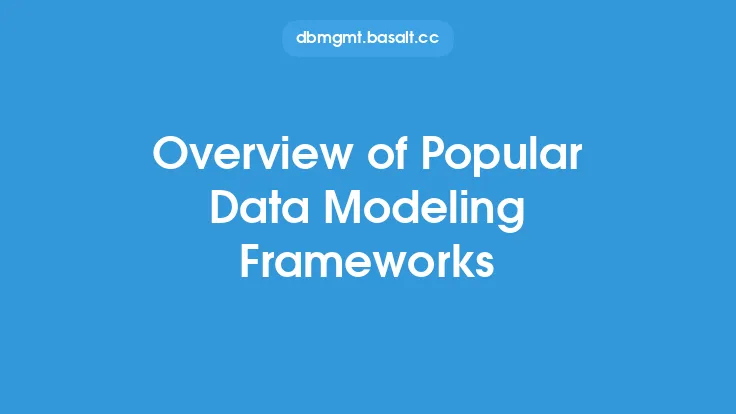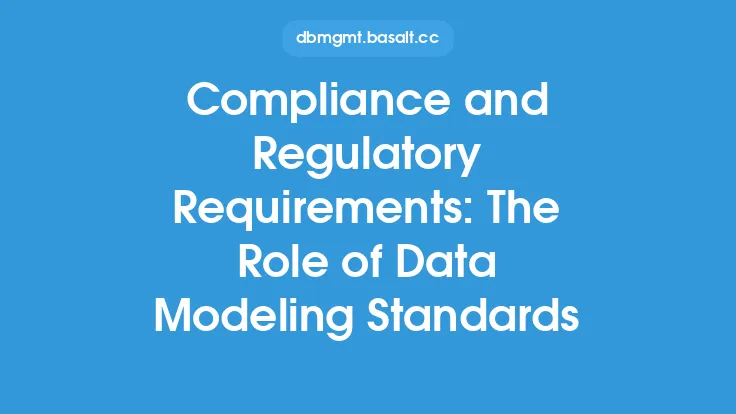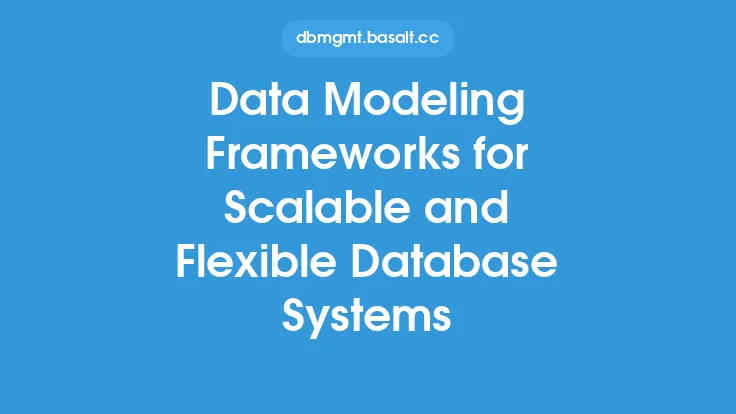Data modeling frameworks are essential tools for designing, implementing, and managing databases. They provide a structured approach to data modeling, enabling developers to create robust, scalable, and maintainable databases. With numerous data modeling frameworks available, each with its strengths and weaknesses, it's crucial to understand their features and compare them to determine the best fit for a particular project.
Key Features of Data Modeling Frameworks
Data modeling frameworks typically offer a range of features that facilitate data modeling, including data structure definition, relationship modeling, data validation, and data transformation. Some key features to consider when evaluating data modeling frameworks include:
- Support for various data models, such as relational, hierarchical, or graph-based models
- Data type support, including primitive types, complex types, and custom types
- Relationship modeling capabilities, including one-to-one, one-to-many, and many-to-many relationships
- Data validation and constraint support, including checks for data integrity and consistency
- Data transformation and mapping capabilities, including support for data migration and integration
- Support for data governance and metadata management, including data lineage and data quality metrics
Comparison of Popular Data Modeling Frameworks
Several popular data modeling frameworks are available, each with its strengths and weaknesses. Some of the most widely used frameworks include:
- Entity-Relationship Model (ERM): A traditional data modeling framework that uses entities, attributes, and relationships to model data
- Object-Role Modeling (ORM): A framework that models data as objects and roles, providing a more flexible and expressive approach to data modeling
- Dimensional Modeling: A framework that models data as facts and dimensions, optimized for data warehousing and business intelligence applications
- Graph Data Modeling: A framework that models data as nodes and edges, suitable for applications with complex relationships and hierarchies
Each framework has its own set of features, advantages, and disadvantages. For example, ERM is widely supported and easy to learn, but can be inflexible and limited in its ability to model complex relationships. ORM, on the other hand, provides a more flexible and expressive approach to data modeling, but can be more challenging to learn and implement.
Data Modeling Frameworks for Specific Data Models
Different data models require specialized data modeling frameworks. For example:
- Relational databases typically use ERM or ORM frameworks, which provide a structured approach to modeling relational data
- NoSQL databases, such as document-oriented or graph databases, often use specialized frameworks that are optimized for their specific data model
- Cloud-based databases may use frameworks that are designed for scalability, flexibility, and high performance, such as Amazon Web Services (AWS) Lake Formation or Google Cloud Data Fusion
- Data warehousing and business intelligence applications often use dimensional modeling frameworks, which provide a optimized approach to modeling data for analytics and reporting
Technical Considerations
When evaluating data modeling frameworks, several technical considerations must be taken into account, including:
- Data type support and compatibility: Ensure that the framework supports the required data types and is compatible with the target database or data storage system
- Scalability and performance: Choose a framework that is optimized for scalability and performance, particularly for large or complex datasets
- Security and access control: Consider frameworks that provide robust security and access control features, such as data encryption and authentication
- Integration and interoperability: Select a framework that provides seamless integration with other tools and systems, such as data integration platforms or business intelligence software
Best Practices for Using Data Modeling Frameworks
To get the most out of data modeling frameworks, follow these best practices:
- Define clear goals and objectives for the data modeling project, including the target database or data storage system
- Choose a framework that aligns with the project's requirements and goals
- Develop a comprehensive data model that includes all relevant entities, relationships, and constraints
- Use data validation and constraint support to ensure data integrity and consistency
- Continuously monitor and refine the data model as the project evolves and new requirements emerge
Conclusion
Data modeling frameworks are essential tools for designing, implementing, and managing databases. By understanding the key features, advantages, and disadvantages of popular data modeling frameworks, developers can choose the best framework for their project and create robust, scalable, and maintainable databases. Whether working with relational, NoSQL, or cloud-based databases, a well-designed data model is critical to ensuring data consistency, integrity, and quality. By following best practices and considering technical factors, developers can unlock the full potential of data modeling frameworks and create databases that meet the needs of their applications and users.





